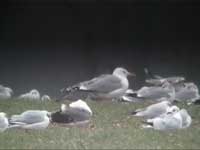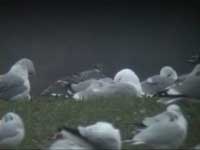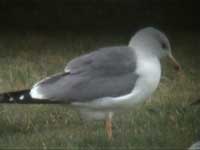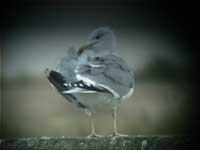surfbirds.com
Adult winter Caspian Gull Larus cachinnans
Summary of Important Features
(Click on any of the thumbnails on the left for a larger image and more text).
Usually a very large gull, with a long primary projection. The head is small with the crown typically rounded, a slight crest noted on some occasions when at rest - when the head is lifted up it is very like a Common Gull. The bill and legs are long, the bill being particularly noteworthy.
Plumage
Head
• Virtually unmarked white at all ages, by early September a few brownish streaks may be just just visible on the hind neck and above the eye. The remainder of the underparts are white.
Mantle
• The mantle tone is frequently very close to that of Common Gull; in direct comparison with argenteus Herring it is darker and alongside michahellis it is paler or equal in tone.
Tertials
• These have narrow white tips and are held flat against the body giving a flat-backed appearance.
Primary moult
A little later than michahellis in my experience, matching that of Herring. In early August an adult had the outer two primaries faded black with P10 having a whitish inner tongue, a white mirror and narrow sub-terminal band. By September, P10 was still retained, P9 was just beginning to grow; P8 was virtually fully grown. The typical pattern of P10 for Caspian is described previously.
Bare parts
Bill colouration changes from a green-yellow in July to a more grey-green colour by September and pale or even richer yellow by mid winter. The eye often appears dark in comparison with argentatus, but may in close views appear pale. The legs are long, thin and coloured flesh, very rarely are they yellow.




Brian Small 1999
References
Jonsson, L, 1998. Yellow-legged Gulls and yellow-legged Herring Gulls in the Baltic, Alula 3/1998: 74-100
Garner, M and Quin, D, 1997. Identification of Yellow-legged Gulls in Britain, British Birds 90: 25-62
Garner, M, Quin, D, and Glover, B, 1997. Identification of Yellow-legged Gulls in Britain 90:369-383
Harris, A, Shirihai, H, and Christie, D, 1996. Macmillan Birders Guide to European and Middle Eastern Birds
Shirihai, H, 1996. The Birds of Israel, Academic Press, London
Bakker, T, 2000. Birding World
Web sites
Martin Reid www.martinreid.com - armenicus, michahellis, cachinnans
Bob Lewis www.bway.net/~lewis/birds/gulls.html - argentatus, michahellis
Steve Hampton www.west.net/~dj/gulls.htm - michahellis, cachinnans, barabensis, armenicus
Rudy Offereins www.geocities.com/RainForest/Jungle/7550
